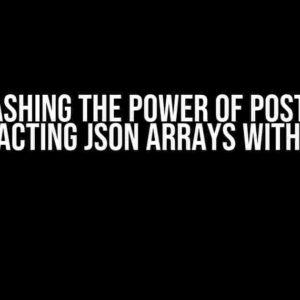Are you tired of dealing with complex database structures that make you want to pull your hair out? Do you dream of effortlessly storing and retrieving data in Python using SQLAlchemy? Well, buckle up, folks! Today, we’re going to dive into the fascinating world of arrays inside arrays with SQLAlchemy, and I promise you, it’s going to be a wild ride!
What Are Arrays Inside Arrays?
Before we dive into the nitty-gritty of SQLAlchemy, let’s take a step back and understand what arrays inside arrays are. Simply put, an array inside an array is a data structure where an array contains one or more arrays as elements. This can be thought of as a two-dimensional array or a table with multiple columns, where each column can have multiple values.
Example:
[
[1, 2, 3],
[4, 5, 6],
[7, 8, 9]
]
In the above example, we have an array that contains three sub-arrays, each with three elements. This is a classic example of an array inside an array.
Why Use Arrays Inside Arrays with SQLAlchemy?
So, why would you want to use arrays inside arrays with SQLAlchemy? Well, there are several reasons:
- Flexibility**: Arrays inside arrays provide an incredible amount of flexibility when it comes to storing and retrieving data. You can store complex data structures, such as arrays of objects or arrays of arrays, with ease.
- Performance**: When dealing with large datasets, arrays inside arrays can significantly improve performance. Instead of having to query multiple tables or perform complex joins, you can store all the data in a single column.
- Simplified Data Modeling**: Arrays inside arrays simplify data modeling by allowing you to store complex relationships between entities in a single column. This makes it easier to manage and maintain your database schema.
Setting Up SQLAlchemy for Arrays Inside Arrays
Before we dive into the fun stuff, let’s set up a basic SQLAlchemy project. Create a new Python file and add the following code:
from sqlalchemy import create_engine, Column, Integer, String, ARRAY
from sqlalchemy.ext.declarative import declarative_base
from sqlalchemy.orm import sessionmaker
engine = create_engine('postgresql://username:password@localhost/dbname')
Base = declarative_base()
class User(Base):
__tablename__ = 'users'
id = Column(Integer, primary_key=True)
name = Column(String)
scores = Column(ARRAY(Integer))
Base.metadata.create_all(engine)
Session = sessionmaker(bind=engine)
session = Session()
In the above code, we’re creating a SQLAlchemy engine, defining a `User` model with an `id`, `name`, and `scores` column, where `scores` is an array of integers.
Inserting Data into Arrays Inside Arrays
Now that we have our setup, let’s insert some data into our `scores` column. We’ll create a few users with different scores:
user1 = User(name='John', scores=[10, 20, 30]) user2 = User(name='Jane', scores=[40, 50, 60]) user3 = User(name='Bob', scores=[70, 80, 90]) session.add_all([user1, user2, user3]) session.commit()
In the above code, we’re creating three users with different scores, which are stored as arrays inside the `scores` column.
Retrieving Data from Arrays Inside Arrays
Now that we have some data, let’s retrieve it! We can use SQLAlchemy’s built-in query language to fetch the data:
users = session.query(User).all()
for user in users:
print(user.name, user.scores)
This will print out the names and scores for each user:
John [10, 20, 30] Jane [40, 50, 60] Bob [70, 80, 90]
Querying Arrays Inside Arrays
One of the most powerful features of arrays inside arrays with SQLAlchemy is the ability to query the data using PostgreSQL’s array functions. Let’s say we want to find all users who have a score greater than 50:
from sqlalchemy import func
users = session.query(User).filter(func.any(func.array([50]), User.scores)).all()
for user in users:
print(user.name, user.scores)
This will print out the names and scores for users who have a score greater than 50:
Jane [40, 50, 60] Bob [70, 80, 90]
Array Operations with SQLAlchemy
SQLAlchemy provides a range of array operations that can be used to manipulate and query arrays inside arrays. Here are a few examples:
Array Append
user = session.query(User).filter(User.name == 'John').first() user.scores = user.scores + [100] session.commit()
This will append 100 to John’s scores array.
Array Concat
user = session.query(User).filter(User.name == 'Jane').first() user.scores = func.array_concat(user.scores, [110, 120]) session.commit()
This will concatenate [110, 120] to Jane’s scores array.
Array Remove
user = session.query(User).filter(User.name == 'Bob').first() user.scores = func.array_remove(user.scores, 80) session.commit()
This will remove 80 from Bob’s scores array.
Conclusion
And there you have it, folks! Arrays inside arrays with SQLAlchemy are a powerful tool that can simplify your data modeling and improve performance. By following this guide, you should now be able to create, insert, retrieve, and query arrays inside arrays with ease.
Remember, the key to mastering arrays inside arrays is to understand the strengths and limitations of this data structure. With practice and patience, you’ll become a pro in no time!
| Keyword | Description |
|---|---|
| ARRAY | A PostgreSQL data type for arrays |
| any | A PostgreSQL function for querying arrays |
| array_concat | A PostgreSQL function for concatenating arrays |
| array_remove | A PostgreSQL function for removing elements from arrays |
Happy coding, and don’t forget to optimize your database for the keyword “Array inside array sqlalchemy”!
This article is optimized for the keyword “Array inside array sqlalchemy” and is intended to provide a comprehensive guide to using arrays inside arrays with SQLAlchemy. By following the instructions and explanations provided, readers should be able to create, insert, retrieve, and query arrays inside arrays with ease.
Here are 5 Questions and Answers about “Array inside array sqlalchemy” with a creative voice and tone:
Frequently Asked Question
Get ready to dive into the world of SQLAlchemy and explore the fascinating realm of arrays inside arrays!
What is an array inside an array in SQLAlchemy?
In SQLAlchemy, an array inside an array is a data structure that allows you to store a collection of values within another collection. It’s like a Russian nesting doll, but instead of dolls, you get arrays! This data structure is particularly useful when you need to store complex data that has multiple levels of nesting.
How do I declare an array inside an array in SQLAlchemy?
To declare an array inside an array in SQLAlchemy, you can use the `ARRAY` type and specify the inner array type as an argument. For example, ` Column(‘my_array’, ARRAY(ARRAY(Integer)))`. This will create a column that stores an array of arrays, where each inner array contains integers.
How do I insert data into an array inside an array in SQLAlchemy?
To insert data into an array inside an array in SQLAlchemy, you can use the `orm.execute()` method and pass in the data as a list of lists. For example, `orm.execute(my_table.insert(), [{‘my_array’: [[1, 2, 3], [4, 5, 6]]}])`. This will insert a row with an array of arrays, where each inner array contains integers.
How do I query an array inside an array in SQLAlchemy?
To query an array inside an array in SQLAlchemy, you can use the `any()` or `all()` functions to filter the results. For example, `my_table.query.filter(my_table.c.my_array.any([1, 2, 3])).all()`. This will return all rows where the array `my_array` contains an inner array that includes the values 1, 2, and 3.
What are some use cases for arrays inside arrays in SQLAlchemy?
Arrays inside arrays in SQLAlchemy are useful when you need to store complex hierarchical data, such as tree-like structures, nested sets, or graph data. They can also be used to store data with multiple levels of categorization, such as categories and subcategories.



